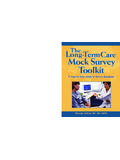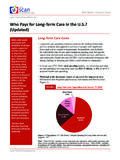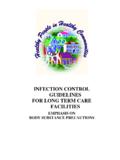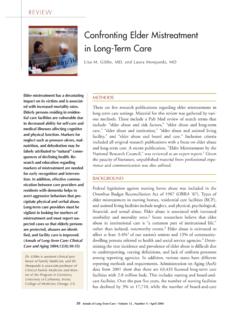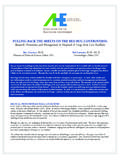Transcription of Long Term Care: Definition, Demand,Cost,and Financing
1 CHAPTER ONELong Term care : Definition, demand , cost ,and Financingby Nelda McCallDuring the last50 years, dramatic changes have taken place inthe way our nation cares for the elderly and the disabled. Once theexclusiveprovinceofthefamily,longterm carehasdevelopedintoasystemprimarily supported by public money and focused on reimbursement forinstitutional care , the most expensive and most restrictive care setting. Asthe U. S. population ages, the development of a more flexible and efficientlong term care system as well as more rational and equitable ways tofinance it will become an increasingly important public policy chapter provides background on the issue of long term care financ-ing,documentingtheservicesthatcon stitutelongtermcare,discussingthedemandf ortheseservices, long term careLong term care refers to a continuum of medical and social services de-signed to support the needs of people living with chronic health ,socialservices.
2 long term care are much more complicated and considerably moredifficult to measure than the goals of acute medical care . While the primarygoal of acute care is to return an individual to a previous functioning level,longtermcareaimstopreventdeteriora tionandpromotesocialadjustmentto stages of care , emphasizing social as well as medical services. While acute careis usually confined to specialty providers, the providers of long term care34 Who Will Pay for long Term care ?are more wide ranging. They include traditional medical providers suchas physicians and hospitals, formal community caregivers such as homecare agencies, facility providers such as nursing homes and assisted livingfacilities, and informal caregivers such as friends or family are described services that are included in these three main typesof long term care : community care , institutional care , and informal care (Figure ).
3 Community CareThe most common types of community care are home health care , adultday care , and hospice Health health care is provided to those recovering froman acute hospitalization (called subacute care ) as well as to those withmore chronic long term care needs. Home care may involve a wide varietyof medical and social services and providers, depending on the patient sneeds. These services include skilled nursing care provided by registeredor licensed practical nurses (LPNs); physical, speech, and occupationaltherapies; professional services provided by social workers, dieticians, casemanagers, nutritionists, and audiologists; home health aide services; andpersonal care , meals, and home-based personal support services such ashelp with homemaking and health agencies numbered approximately 20,000 in 1998, andtheir average visit cost was $75 in 1997 (NAH C1999a).
4 A total of 9,513of these agencies, or about half, were certified to provide care throughFigure : Defining long Term CareCOMMUNITY CAREHome HealthAdult Day CareHospiceINSTITUTIONAL CAREN ursing HomeSupportive HousingINFORMAL CAREIn-Home care and Supportby Friends and FamilyLong Term care : Definition , demand , cost ,and Financing5the Medicare program. The number of Medicare-certified home healthagencies has decreased in the last few years, likely in response to the morerestrictive Medicare payments for home health services and the plannedimplementationofahomehealthprospe ctivepaymentsystem(GAO1999).
5 Home health agencies that do not provide skilled nursing care are noteligible for Medicare certification. Many home care services such as meals,transportation,andotherassistancea reprovidedthroughstate,community,and religious organizations that are not federally discharges in 1996. The most common diagnoses for home healthpatients were circulatory conditions (primarily heart disease and hyper-tension), endocrine diseases (primarily diabetes), and musculoskeletal andrespiratory system problems (Haupt 1998). Data from the 1994 HomeCare and Hospice Survey found that of those home care patients receivingservices, more than four in five (81 percent) had received skilled nursingservices during the previous 30 days; more than one in five (21 percent)had received physical, occupational, or speech therapy; more than half(57percent)hadreceivedpersonalcare;a ndalmostone-quarter(23percent)had received homemaker or companion services (Dey 1996).
6 Adult Day day care programs provide a variety of support ser-vices for impaired adults (mainly the elderly) in a protective setting duringthe day. According to data from Partners in Caregiving, more than half ofadult day care programs offer medical services and rehabilitation therapy;more than three-fourths have nursing services, personal care services, andtransportation; and more than 90 percent provide social services, meals,and recreational therapy/activities (Partners in Caregiving 1995). Most ofthe 4,000 adult day centers operate during normal business hours.
7 A fewprovide care in the evenings and on weekends. Using data from a personalcommunication with the National Adult Day Services Association, an esti-mated 4,000 or more adult day health centers in the United States serveapproximately 88,000 adults (Holguin 1999). Another source indicatesabout 150,000 seniors a day can be accommodated in current adult daycenters (Harling Communications 1999). Ninety percent are nonprofitand affiliated with larger organizations such as nursing homes, medicalcenters, to $185 per day (National Adult Day Services Association 1999) andwere estimated by the American Health care Association (AHCA) to be anaverage of $45 per day (AHCA 1999a).
8 Hospice addition to medical services, hospices provide Will Pay for long Term care ?These services usually involve an interdisciplinary team that includes aphysician, a nurse or nurse s aide, a social worker, a member of the clergy,and volunteers. Team members provide medical services, social services,and respite care for the patient and family. In 1999, approximately 3,200hospices were operating in the United States, of which 80 percent wereMedicare certified (NHO 1999). According to data from the 1995 NationalHospice Organization (NHO) Survey, 65 percent of hospice patients hadMedicare as their source of payment, representing an average of 74 percentof their revenue.
9 To be eligible for hospice services under Medicare, theterminally ill patient must be diagnosed as having six months or less ,hospicesservedapproximately540,000patie nts(NHO1999).Morethan70percentofallhospi cepatientshavecancer,butothercommondiagn oses include AIDS, diseases of the nervous and sense organs includ-ing Alzheimer s and Parkinson s, meningitis, diseases of the circulatorysystemsuchasheartdisease,andd iseasesoftherespiratorysystem(Haupt1998) . The average length of stay was 51 days in 1998 with a median of 25days (NHO 1999).Hospiceprovidersareofvarioustypesa ndincludefreestandinghospitals,home care agency based hospices, hospital-based hospices, and skillednursing facility (SNF) hospice care .
10 The majority of hospices are divisionsof corporations other than hospices. Of the $ billion spent on Medicarehospice care in 1997, most (55 percent) of the hospice outlays went tofreestanding facilities, 27 percent went to agency-based care , 17 percentwenttohospital-basedcare,and1perc enttoSNF-basedhospicecare(NAHC1999b). Medicare per diem rates for hospice care in 1997 were $ forhome care and $ for inpatient care (NHO 1999).Facility CareFacility care includes nursing home care and various kinds of supportivehousing. Services provided include nursing care , personal care services,and room and homes provide institutional care for people recov-eringfromanacuteillnessorforthosew hosechronicneedsrequireskillednursing care , significant assistance with activities of daily living (ADLs)such as bathing, toileting, or transferring, or both.








